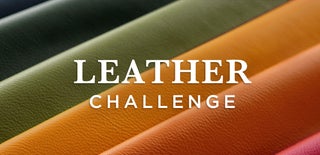Introduction: Laser Cut Leather Stamp
Stamps for tooling leather are usually metal and can cost quite a bit of money. If you have access to a laser cutter and some patience, you can create a stamp that works just as well as a store-bought leather stamp but uses your own custom art.
Step 1: Equipment, Tools, and Supplies
You'll need a few things in order to create your stamp:
- Laser cutter (the one we use at the Claremont Makerspace is a GCC Spirit
- A black and white vector design (here's a great Instructable for creating vector art from a drawing)
- Coreldraw (this came with the GCC Spirit)
- Dowel or block the size and shape of your stamp. We'll use a 1-1/4" piece of dowel from Home Depot.
- Delrin sheet. You want to make sure you're buying Delrin and not HDPE. We initially ordered from Amazon and although the listing said it was Delrin (which is the tradename for DuPont's acetal products) it was definitely not. If you have a lot of problems cutting the material, it might be that you picked up the wrong type.
- Cyanoacrylate glue (aka CA glue or super glue)
To stamp your leather you'll need the following:
- Leather (vegetable tanned -- almost any thickness will work)
- Hammer or mallet
- Hard surface
- Water
- Sponge
Step 2: Bringing in Your Art
Load your black and white vector art into CorelDraw. You might have also just created your vector art in CorelDraw, but either way you need some art on the screen.
Draw a shape that will be the final shape you want the stamp (in our case a circle the size of the 1-1/4" dowel. If you were using a block of wood, you'd probably want to cut a rectangle.
Step 3: Inverting Your Art
To make the laser cut away the area around the art, we'll need to invert the colors. To do this, change the fill of your shape to black (no outline). You'll also need to send the shape to the back so that the graphic can sit on top. Once it's sent to the back, select the outline of your art and change its fill color to white. You'll be left with an inverted version of your graphic.
Step 4: Set Your Cut Border
Once your art is mirrored, you'll need to draw another copy of your shape (or copy and paste the one you already made) and set it to HAIRLINE and the RGB color red. This will be the outline of your stamp that gets cut out.
Step 5: Cut the Delrin
Here are the settings we use for cutting Delrin on the GCC Spirit. You want to set it to Manual Color Fill because otherwise it will create a dithering pattern instead of just engraving away the black areas. The black color is engraved and the red color is cut. You'll notice in the video that our stamp is readable. This is incorrect, but it made a nice pog.
For the engrave, we used 35 speed and 70 power. For the cut it is 2.5 speed and 70 power. Make sure you have raster on and vector off for the engrave and raster off and vector on for the cut.
Please note that these may not be the exact settings you need for your particular laser cutter, but they should be a good starting point.
Step 6: Attach Stamp to Dowel
Put a little CA glue on the dowel and attach the stamp. Let the glue dry stamp side down so the weight of your wood pushes it down.
Step 7: Stamping Your Leather
I'll admit that I'm not a professional leather worker, so the tips and tricks you'll read here are more about wanting to get a stamp on a piece of leather once -- not do any actual tooling. So, my method of casing (prepping the leather to stamp) was to simply run the sponge across it and wait for the water to not look like a puddle on top. I've used a spray bottle as well with good success. Although I was stamping on a granite slab, I found the Delrin stamps better when there's a little give behind the leather. A piece of scrap leather works great for this.
Step 8:
Although the stamp works great on any thickness of leather, it really shines on the thinner leathers. Unlike a metal stamp there are no really sharp edges to bite through and cut into the leather.

Second Prize in the
Leather Challenge













